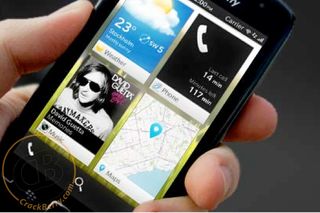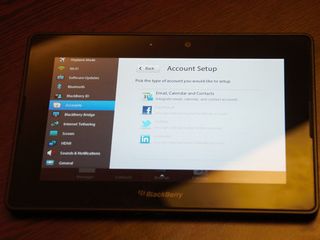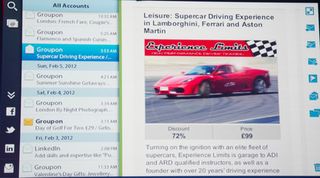How BlackBerry email setup is getting easier
PlayBook 2 and BlackBerry 10 use ActiveSync instead

The imminent BlackBerry PlayBook OS 2.0 adds the missing messaging apps to RIM's tablet, but it also marks a big shift in how BlackBerry devices handle email.
RIM is moving on from the proprietary email system that's been the foundation of its success in business and is joining Google and Apple in adopting a mobile email protocol from Microsoft. But that doesn't mean BlackBerry is abandoning its trademark security or long battery life.
With the PlayBook 2.0 - and future BlackBerry 10 handsets - you won't have to run a wizard on the device and connect to the BlackBerry service to set up your email any more.
Instead, you just fill in the email address and password for your email account, like any other device. If it's a common email service - or any server you've used with a BlackBerry device before - that's all you need to do.

If you're connecting to a work email account, you can click Advanced and fill in the details of the server, but it's still far simpler.
EAS support
But the PlayBook doesn't connect directly to the mail service. BlackBerry software head Vivek Bhardwaj told TechRadar that PlayBook and BlackBerry 10 still take advantage of the BlackBerry infrastructure and servers but things are a lot easier.
"I can put in my Gmail account and what we do in the background is take the username and read the domain [from the email address] and we do all the heavy lifting to get the settings and do all the configuration and send that back down to the device."
Get daily insight, inspiration and deals in your inbox
Get the hottest deals available in your inbox plus news, reviews, opinion, analysis and more from the TechRadar team.
The PlayBook works with standard mail protocols such as IMAP and POP3, but it also supports the popular EAS protocol.

This was developed by Microsoft (originally for Exchange; it stands for Exchange ActiveSync) but it's been widely licensed, and is used by Gmail and Yahoo as well as Hotmail. It's already supported by the majority of smartphones - Android, Windows Phone, Windows Mobile, Nokia, Palm and even iPhones.
In fact, RIM has been the only holdout, and currently you have to install third-party email tools such as AstraSync to use EAS on a BlackBerry handset or tablet.
Switching to EAS instead of RIM's proprietary push email transport is a major change, and it's something of a coup for Microsoft, especially when Bhardwaj praises it as an open standard.
"This is a shift in architecture, based on what we want to deliver as a company. The BlackBerry Internet Service and the BlackBerry Enterprise Server have served us well for the last decade.
"Over time, more consumers have latched on to smartphones, and enough of the industry is at that tipping point so we do need to be about standards. It's about open standards and an open ecosystem."
Get email faster

EAS has some major advantages. It's a proper push protocol that copes with multiple email folders. Mail will arrive on a device using EAS when it arrives on the server. That's a big improvement over the 15 minutes you wait to check for new emails you get with BIS today (the way any BlackBerry that's not managed by a business gets email).
Emails you read and delete on your phone will be marked as read or deleted if you look at your mail on the web. This happens with BlackBerry devices today, if you have it set up correctly.
But messages you read in webmail or with another client will be marked as read on your BlackBerry as well, which doesn't always happen using the current system.
And while there will probably be a setting to choose whether to download the whole of really long messages, you won't only get the first 2K of each message. That should mean no more scrolling down to the More prompt and waiting for the rest of the message to arrive.
You'll finally also get your contacts and calendar details synced from your email or calendar service directly to the PlayBook or BlackBerry 10 smartphone, even if you're not connected to an enterprise BlackBerry system.
Secure and energy efficient
But what about the real advantages of BIS and BES: the security and power efficiency?
Mail will be just as secure, promises Bhardwaj. "The device talks EAS but we wrap security around it. The messages go through a secure tunnel that's created by BIS or BES, but the transport inside it is EAS."
Businesses still get to manage BlackBerry devices and control settings on them as well.
And it's the connection between the server and the phone that keeps power use low (and compresses the data sent back and forth), which still uses the BlackBerry system. If battery life changes for BlackBerry 10, we wouldn't point the finger at the mail connection.
Loosening the connection between BlackBerry devices and the BlackBerry servers might have other advantages too. It's no longer one person, one BlackBerry, talking only to a BlackBerry server. PlayBook is going to get BBM (just not in this update).
Could this open up the possibility of BBM coming to other devices that aren't BlackBerry? We don't know, but it's a tempting idea.
Mary (Twitter, Google+, website) started her career at Future Publishing, saw the AOL meltdown first hand the first time around when she ran the AOL UK computing channel, and she's been a freelance tech writer for over a decade. She's used every version of Windows and Office released, and every smartphone too, but she's still looking for the perfect tablet. Yes, she really does have USB earrings.

The road to analytics excellence is paved with automation

This has to be the most absurd portable power station ever launched — Asus's Mjolnir throws the hammer at rivals with innovative design that's likely to divide opinions

Pixel's new satellite feature could show people where you are on Google Maps